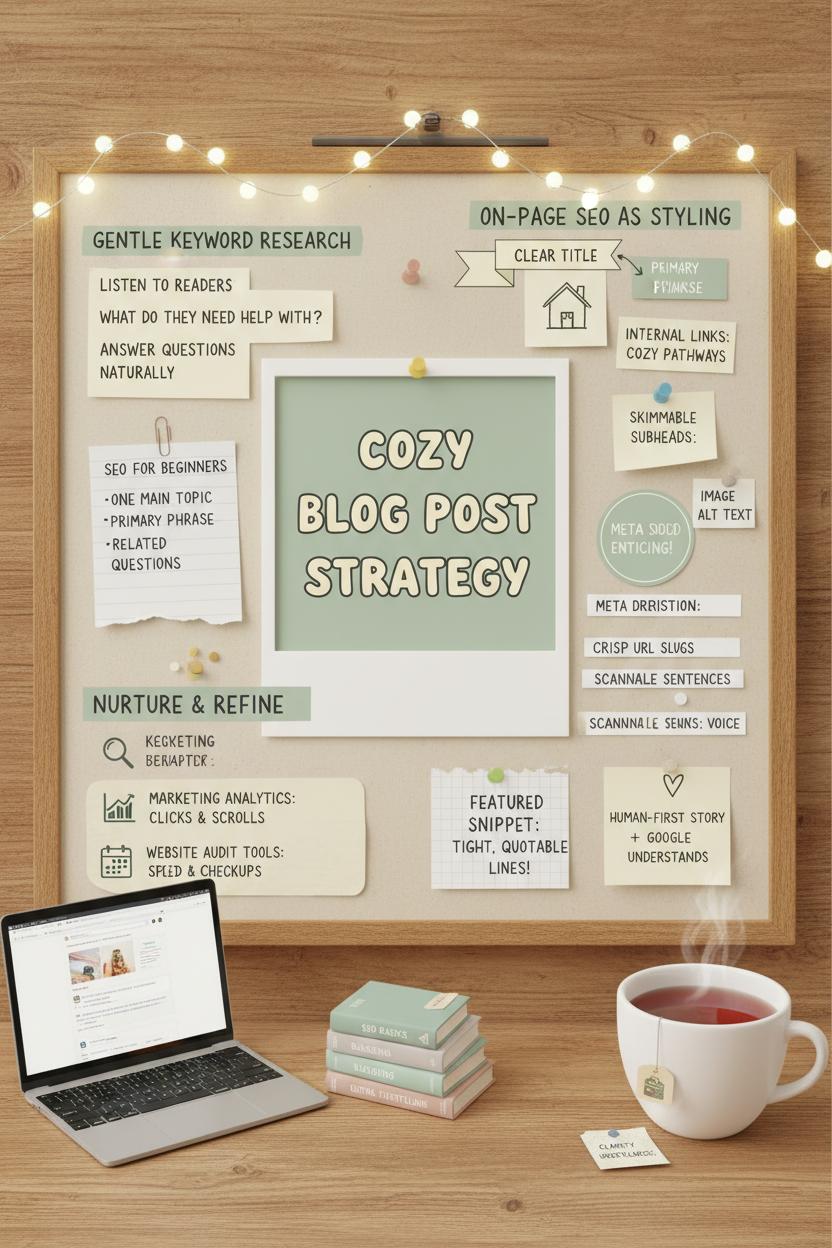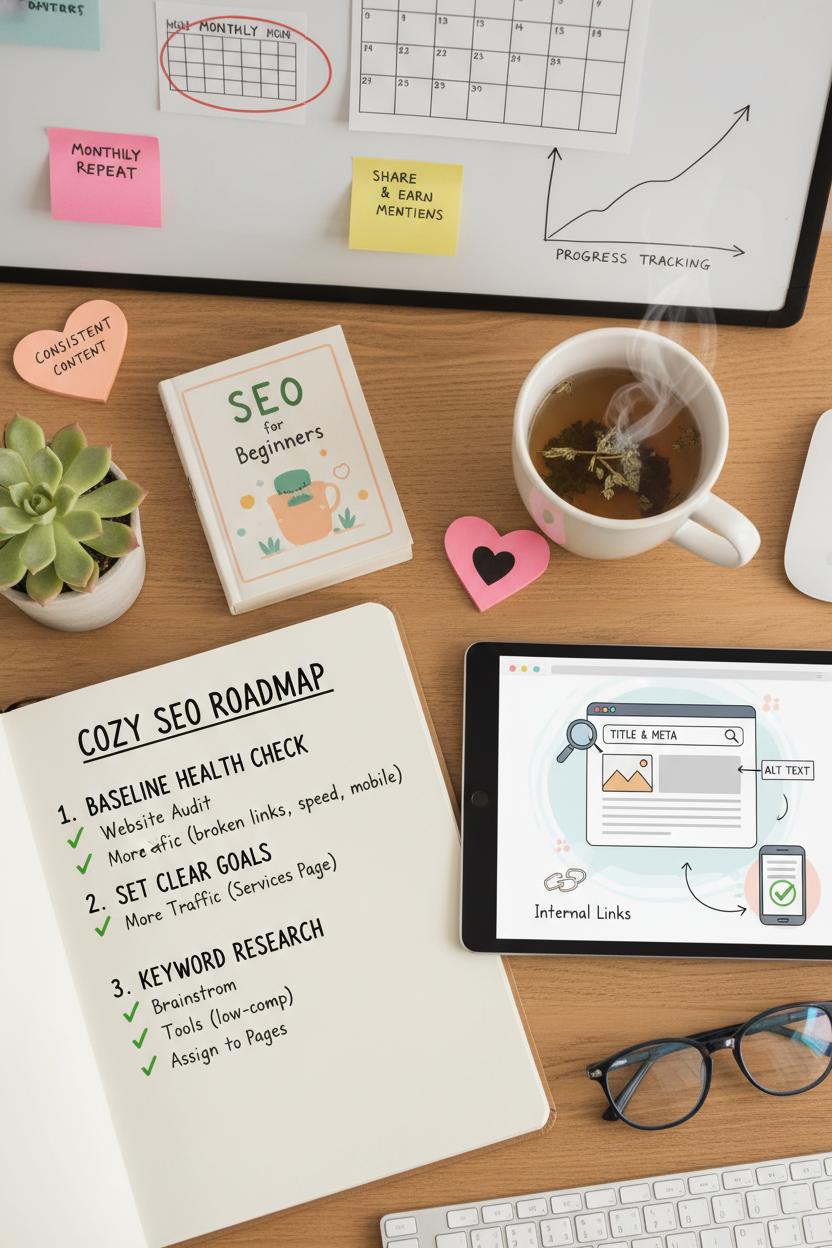New to search engine optimization? This beginner-friendly SEO guide breaks down simple steps to rank higher fast. Perfect SEO for beginners: learn keyword research that actually converts, on-page SEO fixes that boost clicks, and easy wins you can implement today. We’ll point you to helpful SEO books, keyword research tools, marketing analytics software, website audit tools, and digital marketing guides so you can measure results and keep improving. Ready to turn your website into a traffic magnet? Pin this, save it, and start optimizing now.
What Is Search Engine Optimization? A Beginner SEO Guide

Search engine optimization is simply the art and science of helping search engines understand your content so they can match it with the people who are already looking for it. Picture a friendly librarian with a massive card catalog: your pages need clear labels, tidy structure, and a strong sense of what each page is about. This SEO guide will walk you through the basics without the jargon. Search engines crawl your pages, index what they find, and then rank results by relevance and quality. Your job is to make that journey effortless—showing what your page covers, why it’s useful, and why it deserves a spot near the top.
For SEO for beginners, start with keyword research, which is really audience research in disguise. Jot down the questions your readers ask, then explore variations with keyword research tools to find phrases that are specific, intent-rich, and realistically competitive. Build your on-page SEO around those phrases: write a clear title tag and meta description, use headers that read like a mini-outline, and sprinkle descriptive alt text on images. Keep paragraphs skimmable, add internal links to related posts, and make sure your site loads quickly on mobile. A quick scan with website audit tools can surface broken links, sluggish pages, or missing tags, while basic marketing analytics software helps you see which posts attract traffic and where people drop off.
If you love a cozy learning moment, curl up with a few SEO books or digital marketing guides to deepen your understanding, and keep a simple checklist for each new post so best practices become second nature. Think of it as tidying your content pantry: label everything, group similar ideas, and restock with fresh updates over time. Search engine optimization rewards clarity and consistency, not tricks, so small, steady improvements matter. Track what works, revisit older posts with better keywords or structure, and keep experimenting. Before long, you’ll feel confident turning ideas into discoverable pages that your audience—and the algorithms—can’t help but find.
The Essential SEO for Beginners Toolkit: Digital Marketing Guides and SEO Books

When you’re just starting out, think of your toolkit like a pretty little caddy on your desk—filled with things you actually use, not clutter. Begin with a solid SEO guide and a couple of digital marketing guides you can flip through whenever you’re unsure. I love keeping SEO books nearby with dog‑eared pages and highlighter tabs; they translate the big world of search engine optimization into friendly, step‑by‑step feels. For SEO for beginners, look for titles that explain how search engines work, offer simple checklists for on-page SEO, and give real examples of how small tweaks can move the needle. A cozy reading session with a good guide can save you from late‑night Googling and give you a clear plan you can actually follow.
Next, layer in tools that make the work easier and more fun. Use keyword research tools to hunt for phrases your audience is already whispering to Google—think long‑tail gems with lower competition that make you feel like you’ve cracked a secret code. Pair that with website audit tools that scan your pages for broken links, sluggish images, or missing meta titles, so your site gets cleaner and faster with every pass. Then, peek at your traffic with marketing analytics software to spot which posts are getting love and which need a refresh. This trio turns vague guesses into confident moves, and your keyword research won’t just sit in a notebook—it will shape headlines, intro paragraphs, and those tiny details that add up in on-page SEO.
Finally, make it a ritual. Keep a simple spreadsheet of target keywords, publish dates, and performance notes, and revisit your favorite digital marketing guides when you need a nudge or a new angle. Treat your toolkit like a capsule wardrobe: a few well‑chosen SEO books, reliable keyword research tools, go‑to website audit tools, and one clean dashboard of marketing analytics software. With these pieces, you’ll feel steady and inspired, able to map out content, polish pages, and track the wins as they stack up. It’s less about doing everything at once and more about building a calm, repeatable rhythm that quietly lifts your rankings week by week.
Keyword Research 101: How to Use Keyword Research Tools to Find Winning Topics

Think of keyword research as the cozy creative session before you decorate a room—you’re gathering swatches, testing textures, and figuring out what feels right. Start by listing seed ideas your ideal reader would type into Google: problems they’re trying to solve, questions they whisper into search at midnight, and the exact words they use. Then plug those seeds into your favorite keyword research tools to discover related phrases, search volume, and difficulty. Look for long-tail keywords (those more specific, multi-word phrases) because they’re usually less competitive and more intent-rich—perfect for SEO for beginners. Peek at autocomplete suggestions and “People Also Ask” to capture real-language questions. From there, skim the top results to understand intent: are people looking to buy, compare, or learn? That context helps you choose topics that match what the searcher actually wants, which is the quiet magic behind great search engine optimization.
Once you’ve got a shortlist, cluster similar terms into themes and plan one strong page per cluster. This is where on-page SEO gets deliciously practical: weave your primary keyword into the title tag, H1, meta description, URL slug, first paragraph, subheads, and image alt text—gently and naturally, like seasoning, not like a salt shaker explosion. Use secondary keywords to round out the content so it answers the whole question, not just a slice. Save your ideas in a simple content calendar and track performance over time using marketing analytics software; pair that with website audit tools to keep pages healthy and speedy. If you want a deeper dive, skim a few SEO books and digital marketing guides to learn frameworks you can reuse for every post. This mini SEO guide is designed to get you moving, but browsing updated resources and experimenting with different keyword research tools will sharpen your instincts. Keep it simple: pick a topic, validate it with data, align it with intent, and publish with care. Do this consistently and you’ll build a library of winning topics that quietly stack rankings and traffic, one helpful page at a time.
Content That Ranks: Search Engine Optimization Tips for Blog Posts

Picture your next blog post like a cozy mood board: a clear theme pinned in the center, supported by a handful of phrases your readers are actually searching for. Start with gentle, intentional keyword research—think of it as listening in on what your audience needs help with—and let those insights inspire your outline. If you’re an SEO for beginners type, keep it simple: one main topic, one primary phrase, and a couple of related questions you can answer naturally in the flow. This isn’t about stuffing words; it’s about crafting a helpful, human-first story that aligns with search engine optimization, then polishing the details so Google understands exactly what you offer. A friendly SEO guide (or a few well-thumbed SEO books and digital marketing guides) can help you brainstorm angles, but the heart of your post is clarity, usefulness, and a voice readers want to come back to.
As you write, lean into on-page SEO like you would style a room—small touches add up. Give your post a clear title that includes your primary phrase, then open with a first paragraph that sets expectations and mirrors the searcher’s intent. Break up text with skimmable subheads, place your keyword early, and weave variations into naturally occurring spots like image alt text and a short, enticing meta description. Internal links are like cozy pathways through your site—guide readers to related posts—and don’t forget crisp URL slugs, scannable sentences, and descriptive anchor text. If a common question pops up in your keyword research, answer it in one tight, quotable line to earn featured snippet potential. Your goal is a beautiful balance: content that reads like a conversation but checks the boxes search engines look for.
Finally, nurture what you publish. Peek at performance using marketing analytics software to see which headlines win clicks and which sections keep people scrolling. Schedule quick checkups with website audit tools to catch slow images or broken links, and refine future topics with keyword research tools as your library of posts grows. If you love a tangible resource, tuck a few SEO books next to your laptop and bookmark practical digital marketing guides for weekend reading. With steady tweaks and a listener’s mindset, your blog becomes both a welcoming home for readers and a tidy, findable space for search engines.
Understanding Search Intent: Smarter Keyword Research for New Sites

Before you chase high-volume phrases, pause and ask: what is this person really trying to do? That little question is the secret sauce of keyword research for a brand-new site. Think of search intent as the mood board behind every query—informational (“teach me”), navigational (“take me to”), commercial investigation (“help me compare”), and transactional (“I’m ready to buy”). When you align your content to that intent, your pages feel instantly useful, which is exactly what search engine optimization is all about. For SEO for beginners, this SEO guide section is your gentle nudge to stop guessing and start observing. Type your seed ideas into Google, peek at the first page, and notice what dominates: how-to posts, product pages, listicles, or local maps. The SERP layout tells you the intent; your job is to create the most satisfying answer in that format.
Start small and specific. Build clusters around long-tail phrases that match the stage your reader is in. If they’re in learning mode, serve a soothing tutorial with clear steps; if they’re comparing options, craft a thoughtful showdown with pros, cons, and use cases. Then weave in on-page SEO like a stylist—natural headings that mirror sub-questions, crisp meta descriptions that set expectations, and internal links that guide readers to the next helpful stop. Treat keyword research as a conversation, not a checklist; read People Also Ask, scan related searches, and borrow the language your audience already uses so your content feels familiar at first glance.
Tools can make this feel less like guesswork and more like a cozy system. Explore keyword research tools to uncover variants and seasons, then validate your picks with light doses of marketing analytics software to see which pages win attention and which need love. Run occasional checkups with website audit tools so your technical basics don’t trip up great ideas. If you enjoy learning with a mug in hand, browse SEO books and digital marketing guides to deepen your instincts and spot patterns faster. Remember, search engine optimization rewards empathy over hype: choose the intent you can satisfy best, deliver it beautifully, measure, and refine. When your content answers the exact question someone had in mind, ranking starts to feel less like luck and more like a cozy habit you can repeat.
Local and Mobile SEO for Beginners: Easy Optimizations for Visibility

If you serve a neighborhood, a city, or even a cluster of nearby towns, local and mobile tweaks are the secret sauce that help people find you in real life. Start by polishing your Google Business Profile like you’d style a welcoming storefront: add bright photos, choose the most accurate categories, set holiday hours, and write a cozy, keyword-rich description that mirrors the phrases people actually type, such as “florist in Old Town” or “best tacos near me.” Keep your name, address, and phone number consistent everywhere—from your website to Yelp, Apple Maps, and Bing Places—because search engines treat that consistency like a trust signal. Inside your site, bring on-page SEO into the neighborhood by weaving local terms into title tags, meta descriptions, and H1s, and sprinkle in landmarks or service areas on your contact and service pages; an embedded map, clear directions, and a few cheerful, genuine review snippets can go a long way. If you’re following this SEO guide as part of your broader search engine optimization plan, micro-moments matter: encourage reviews, reply with warmth, and add simple FAQs that answer location-specific questions.
Mobile is where most local discovery happens, so make the phone experience feel effortless and fast. Aim for quick-loading pages with compressed images and gentle, minimal scripts, keep tap targets comfortably large, and let important actions float to the top—think click-to-call buttons, “get directions,” and short forms that don’t ask for the moon. Use website audit tools to spot sluggish pages or layout shifts, then track what resonates with your audience through marketing analytics software so you can see which pages lead to calls, bookings, or in-store visits. For content ideas, lean on keyword research to uncover everyday phrasing, and let keyword research tools help you find low-competition local modifiers that fit naturally into your copy. If you’re craving a deeper dive, browse approachable SEO books or digital marketing guides that expand on SEO for beginners, and keep refining your local pages season by season—new photos, timely promos, and updated services—so they feel alive. With these gentle improvements, your local presence becomes both discoverable and delightful, the way good on-page SEO should feel when it truly serves people nearby.
Your Action Plan: A Step-by-Step SEO Guide and Checklist

Take a deep breath and picture this as your cozy, no-stress roadmap—a simple SEO guide you can follow in an afternoon and repeat every month. First, get your baseline: run a quick health check to see what’s working and what’s not. A light sweep with website audit tools will surface broken links, slow pages, or mobile snags so you’re not guessing. Next, set one or two clear goals—more traffic to a services page, more email signups, or better visibility for a flagship blog post—so every move you make in search engine optimization ladders up to something tangible.
Now comes the heart of SEO for beginners: keyword research. Brainstorm the words your ideal reader would type when they’re trying to solve a problem you can help with, then expand that list using keyword research tools to find low-competition phrases with decent search volume. Pick one primary keyword per page and a few related terms. Turn those into a content plan: one page equals one main intent. From there, polish your on-page SEO. Write a clear, click-enticing title tag and meta description, use your primary keyword early in your H1, weave related phrases into subheads, and keep paragraphs skimmable. Add descriptive image alt text, link to at least two relevant pages on your site, and guide readers to a next step with a friendly call to action.
Give your site a little spa day: compress images, tidy your URL structure, double-check mobile friendliness, and submit your sitemap if you haven’t already. Publish consistently helpful content—how-tos, checklists, and quick wins—and sprinkle gentle internal links to connect related posts like a curated collection. Share your pieces where your audience hangs out and look for natural opportunities to earn mentions, such as contributing a quote or resource.
Finally, track progress without obsessing. A quick weekly glance at marketing analytics software will show which pages are rising, which keywords are nibbling at page one, and where to refresh. Keep learning in small sips with SEO books and digital marketing guides, and revisit this checklist monthly. Little steps, lovingly repeated, create big momentum.
Recommended Resources: Best SEO Books and Digital Marketing Guides to Keep Learning

If you’re ready to keep the momentum going, think of this as your cozy study nook for search engine optimization. Start by mixing a few timeless SEO books with easy, visual reads you can dip into between tasks. The Art of SEO is like a masterclass in your back pocket, while SEO 2024 by Adam Clarke gives you a practical, step-by-step vibe that’s perfect for SEO for beginners. For strategy that goes beyond tactics, Product-Led SEO by Eli Schwartz helps you connect rankings with real business growth, and Content Chemistry by Andy Crestodina makes content and on-page SEO feel intuitive and doable. If you like bite-size learning, bookmark the free Moz Beginner’s SEO Guide and Backlinko’s checklists—each is a friendly SEO guide you can skim with a latte in hand. As your bookshelf and tabs fill up, sprinkle in broader digital marketing guides so you can see how SEO weaves into email, social, and paid media without feeling overwhelming.
Now, pair those reads with hands-on practice using a few keyword research tools and you’ll level up fast. Start simple with Google Keyword Planner or Ubersuggest, then graduate to Ahrefs or Semrush when you’re ready for deeper keyword research, competitive insights, and content gaps. Keep an eye on what’s working with marketing analytics software like Google Analytics 4 and Looker Studio, and let Google Search Console be your daily pulse check for impressions, clicks, and queries. For quick health checks and tidy technical fixes, website audit tools such as Screaming Frog or Sitebulb make it easy to spot broken links, thin pages, and missing meta details so your on-page SEO can shine. Round it out with a few trusted newsletters and podcasts—Moz, Ahrefs, and Search Engine Roundtable—to stay current without doom-scrolling. Whether you browse Amazon for highly rated SEO books and digital marketing guides, or build a reading list from these favorites, the goal is the same: learn a little, test a little, and keep stacking small wins until your site tells a bigger story in search.
Conclusion
Take a deep breath—you’ve got this. With this SEO guide, you learned how search engine optimization starts with clear keyword research, simple on-page SEO tweaks, and steady, quality content. For SEO for beginners, small steps add up: write helpful titles, tidy your meta tags, link thoughtfully, and keep measuring. Brew a coffee, open your checklist, and polish one page at a time. Save this post for rainy-day tune-ups, celebrate tiny wins, and watch your rankings grow. Cozy, consistent effort is the secret to lasting visibility—and a website you’re proud to share.